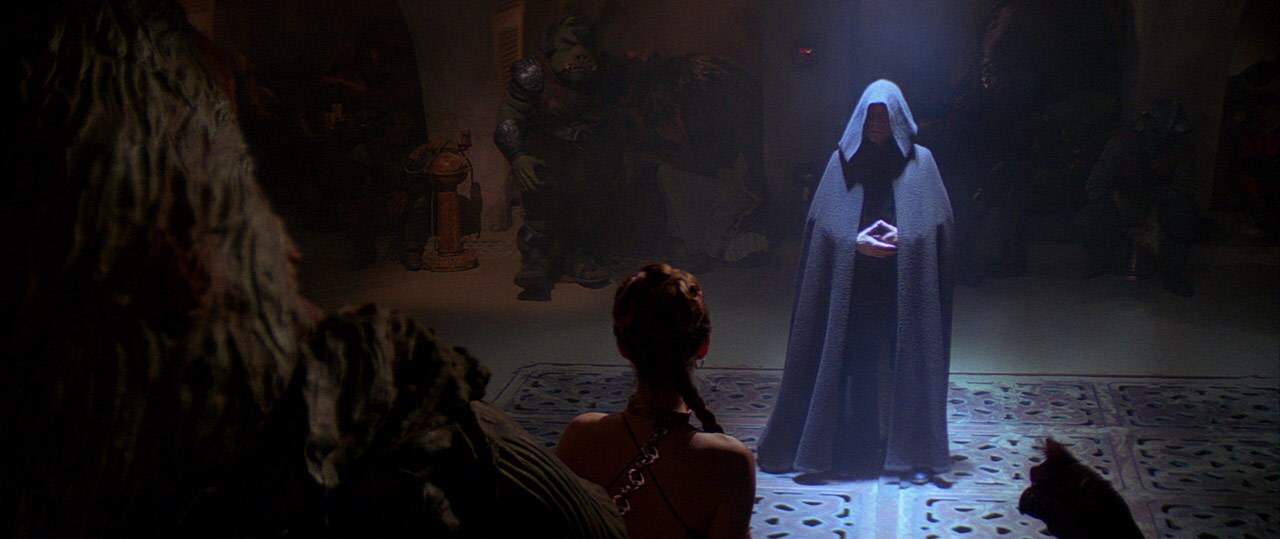In My Favorite Scene, StarWars.com invites special guest writers to discuss which one scene or moment in the saga most resonates with them.
There’s a simple answer and a complicated answer to what my favorite Star Wars scene is, but they’re both about the same scene. Okay, it’s more of a sequence, so I’m kind of cheating, but the whole Jabba’s palace rescue that Return of the Jedi opens with is, was, and always will be the ultimate Star Wars gold for me.
The simple part of why comes courtesy of Three-Year-Old Me. Jedi was one of the first movies I saw in the theaters and it blew my mind, terrified me, woke me up, enraptured me completely. All that flying around and shooting stuff was cool and all, but the BEST part, the part I kept thinking about for years and wanted to watch over and over again, was that opening sequence. Why? Because MONSTERS!!!! *makes monster noises*
I watched a behind-the-scenes doc about the making of Jedi a few years later and that was it, my life was over. I just wanted to make/hang out with weird creatures of all sizes for ever and ever, amen. All those layers of foam and latex and the hidden animatronics devices and clever ways to hide the puppeteers and combinations of creativity, craft, and technology and and and aaaaah!! I filled notebooks for days with monsters.
It’s the “all shapes and sizes” part that really makes Jabba’s palace stand out. The cantina in Episode IV was cool, and we had the Ithorian and some other interestingly shaped masks, but you still had the sense they were guys in suits, ultimately. With Jedi, a whole new level of creatureness had been attained. There were beings that no human could fit inside of and beings that at least three humans had to fit inside of. These things slithered, hopped, trundled, squirmed, stomped, and rolled through the shadows of that Tatooine gangster’s paradise. They all felt so very alive, and though we didn’t know all their wonderful backstories, the care put into all those fashion choices and badass gear implied that each one of them trailed a whole complex and wonderful life of galactic shenanigans in their wake.
That’s great storytelling.
Which brings me to the more complicated answer, the one that doesn’t come courtesy of Little Me, but rather, Fully-Grown-And-Now-A-Writer Me: The Jabba’s palace sequence is a stellar example of narrative art.
You really never know what’s going to happen when you go back and rewatch the movies you loved as a kid. A good chunk of the time, you’re bored to tears or appalled or end up ranting on Twitter late into the night. But sometimes, that magic holds up through the years, and Return of the Jedi definitely delivers. On a simple aesthetic level, it gives us many of the elements that make the whole Star Wars world so great: far from the sleek, fake plastic feel of so many sci-fi franchises, the world of Star Wars is dusty, rusty, and adamantly refuses to fit into easily pre-prescribed boxes. It’s got its own rhythms and flows, and though they’re somehow familiar, echo with certain truths and archetypes, they’re also something brand new, audacious. It’s like finally hearing D’Angelo’s Voodoo after listening to a lifetime of overprocessed, soulless pop. A sequence like this one, deep in the desert, is filmed like a noir movie: long shadows, whispered conspiracies and counter conspiracies, a hooded stranger in a smoky den, negotiations and, in an unlikely moment, a love song. Well, not a song exactly, but certainly a frantic, doomed glimpse of something much more beautiful than all that slime and corruption.
As great as all those monsters that entranced Little Me are, they serve the story, not the other way around. The narrative doesn’t bend itself into impossible calisthenics just to show off some fancy special effects. Instead, we get to watch a carefully laid plan come together and fall apart and then smash back together against all odds.
In storytelling, each piece of the overall arc should function as a microcosm of the whole. Each scene is a story, with a beginning, middle, and end, and -- most importantly -- a turning point. Here we have multiple threads entwining -- Leia, Lando, and Chewie getting themselves into position, Luke’s ploy with the droids and eventual arrival, Han’s recovery from carbonite. After each thread is in place, they all explode at the same time in that perfect climactic showdown on the barge. Each character moves from imprisonment or disguise to being an active part of the grand plan to eventual triumph. In the course of all that, they help each other, put everything on the line, almost get digested slowly over the course of a thousand years, and mend old friendships while fighting off Jabba’s henchmen. Their internal and external struggles become one amidst exploding skiffs and squirming tentacles. In classic Star Wars fashion, multiple conflicts unravel simultaneously, overlap, and finally come together just right, leaving us breathless and ready for whatever comes next.
And also: MONSTERS!!! YARRRRRGGG!!!
Last Shot by Daniel José Older is available now.
Daniel José Older is the New York Times bestselling author of the young adult series The Shadowshaper Cypher, the Bone Street Rumba urban fantasy series, and the middle-grade historical fantasy Dactyl Hill Squad. He won the International Latino Book Award and has been nominated for the Kirkus Prize, the Mythopoeic Award, the Locus Award, the Andre Norton Award, and the World Fantasy Award. Shadowshaper was named one of Esquire’s 80 Books Every Person Should Read. You can find his thoughts on writing, read dispatches from his decade-long career as an NYC paramedic, and hear his music at his website, on YouTube, and on Twitter.

















